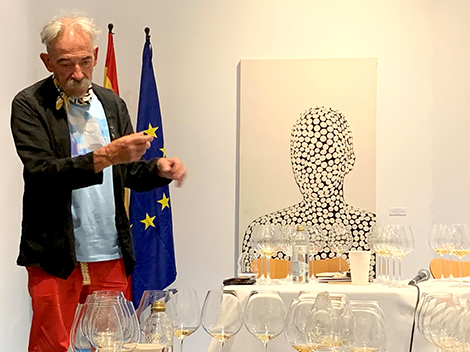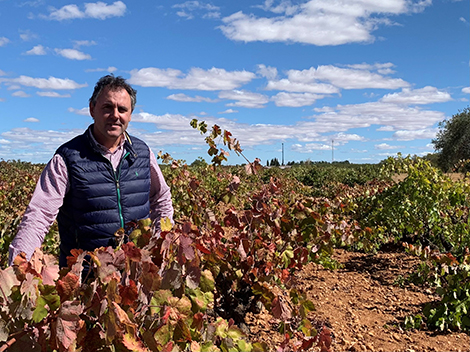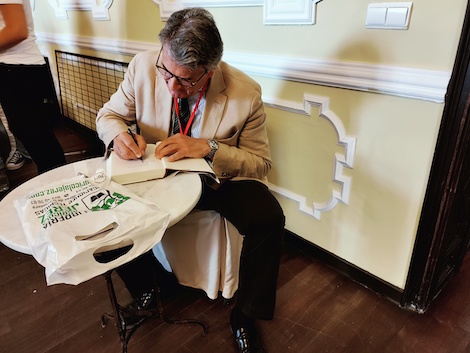
The wines of Emilio Rojo are not easy to taste. The few bottles that are made sell quickly and are probably drunk while still young. Not even Emilio himself has cellared his own wine.
That’s why we felt so privileged to attend a unique vertical tasting held in Madrid on 10th October and conducted by Emilio together with his long-time distributor Quim Vila, from Vila Viniteca. The event, organised by Alma de Carraovejas, the new owner of the Ribeiro estate, was appropriately held in Casa de Galicia. The bottles were part of the private collection owned by Luis and Alejandro Paadín, the authors of Guía de Vinos, Destilados y Bodegas de Galicia, who generously shared them with all the attendants.

Born in 1951, no one would guess that Emilio Rojo is in his seventies. He is slim and slender, much like when he used to spend his days tending the 1,2Ha vineyard that is the sole source of grapes for his wine since the 2000 vintage. Previously, the fruit came also from the Arnoia valley, an area where smallholdings can be incredibly small. His first vintage, presented in a rhine bottle, was 1987. The wine is a blend of Treixadura, with small amounts of Loureira, Godello, Albariño, Torrontés, Lado or Caíño Blanco.
We told his story in an article published in the first year of SWL. It is remarkable how hard he pushed himself to make the best possible wine from that plot of land that was his livelihood. This vertical tasting helps us to pick up the story almost where we left it.
The handover
In 2019, Emilio Rojo's life took a turn. The year began with a solid purchase offer from Alma Carraovejas. The Ribera del Duero group had set its sights on Viña Meín and saw Emilio's small estate as the icing on the cake to fulfil its aspirations in the area. It also guaranteed continuity -as Emilio and Julia González, his partner, had no children, they were given the opportunity to remain involved in the business. During the tasting, Rojo recalled celebrating the sale at Sacha, one of the couple's favourite restaurants in Madrid, as one of the happiest moments of their lives. Sadly, Julia fell ill with cancer shortly afterwards, and passed away in October the same year. I took the photo below during a tasting with their American importer in April 2019.

The 2016 vintage made in her memory and named after her marked the end of the tasting and showed the extra complexity of its longer ageing under lees. It was a 500-litre tank that Emilio had set aside for his wife -she always complained that, due to Emilio's zeal in its sale, she was unable to drink their own wine. According to Laura Montero, who took over winemaking after the arrival Carraovejas, the wine was delicious and the fact that it was bottled in magnum has conferred it extra freshness.

Both the spirit of Emilio Rojo’s wines and the winemaking have remained virtually unchanged under the new ownership. According to Laura Montero, "Emilio's plot was very well looked after and the vines had the necessary vigour to make fresh whites, even though it’s not easy due to the pressure of diseases. As it faces east, it enjoys the morning sun, which is less powerful, but it means that the temperature also rises when the humidity is higher".
The most significant change was the shift to organic farming, something that Emilio himself had always envisaged. Adapting to this new reality caused a significant drop in yields, particularly in 2020, the first vintage to be farmed entirely in this way. "Our aim is to have strong, balanced plants", Montero points out.
Cover crops have also been introduced (previously tilling was the norm) to control vigour and encourage more life in the soils, although Montero acknowledges that this trebles the work and reduce yields. Right now, the vines produce 3,500 to 4,000 kg/ha, considerably lower than in the previous stage. This means there are fewer bottles available.
Grapes are still harvested in several passes to ensure optimum ripeness. In a difficult vintage like 2021, they went through the vineyard four times; in 2022, an easier harvest due to the absence of rain, three passes were enough.

Emilio Rojo with new owners José María and Pedro Ruiz from Alma Carrovejas and winemaker Laura Montero
There have been no major changes in the winemaking. The focus remains on working with the lees -this was Emilio's main obsession, along with refilling the tanks so that the wine was always in perfect condition. Ageing times, which ranged between 14 and 16 months, have remained unchanged, but bottle ageing has been extended. Thus, the 2019 vintage, which would have normally been released in 2021, will not leave the winery until November this year. Bottling will also be more exacting (previously it was done by hand), as will be the choice of corks to favour cellaring. Emilio Rojo succinctly summed up the changes: "I am intuitive, Laura is surgical".
The only wine in the tasting which was not fully crafted by Emilio himself was the 2019, a relatively young Ribeiro for Emilio Rojo standards, impeccable and precise with well-defined white and citrus fruit, dried herb aromas, and a broad, sapid, long palate. Only 2,000 standard bottles and 300 magnums have been produced.
The 2010s
Three bottles were opened for each vintage so there were logical variations that meant tasters had different experiences. Nevertheless, the 2010 series was outstanding and the evolution of the wines in the bottle, 12 years down the line, was very interesting. As Rojo did not provide much technical information to set the vintages in context, I have drawn on the weather data supplied by Alma Carraovejas, our own vintage reports going only as far back as 2014, and Rojo's comments as quoted by Luis Gutiérrez in his tasting notes for The Wine Advocate over time.
Generally speaking, the main common feature in all wines was their mouth-filling consistency, which didn’t feel unnatural or overly unctuous as a result of their ageing under lees. On the nose, some vintages offered stronger herbal notes, often mixed with flint aromas while others were more restrained, showing fine reduction (sunflower seeds) and Burgundy-like creaminess. There were the odd dairy nuances that suggested some wines might have undergone malolactic fermentation, even if Emilio always tried to avoid it.
Herbal notes dominated the nose of the fresh, lively 2018 vintage almost in an exuberant way or as if the presence of Loureiro grapes was more obvious on that year. I had a similar impression with the 2014, although the wine was subtler, the fruit more restrained and with additional petrol aromas. It was a cold, rainy vintage, so maybe that meant less structure and length, but the wine was truly fine and enjoyable. Under extreme rainy conditions and with problems for ripening, the 2013 was the lightest of the series with the presence of some herbaceous notes.

I think my favourite vintage among the rainy years was 2016. As temperatures were higher, the wine felt more citrusy than herbal, with full, subtle ripeness. It was truly elegant and delicious to drink. Consider yourself fortunate if you have a bottle in your cellar.
There was a second group of more structured wines that often corresponded to drier vintages with higher temperatures during the ripening season but were nevertheless balanced. One of them was the opulent 2017 (a severe frost at the end of April followed by very hot weather), with candied citrus fruit and mellow acidity, but far from overripe. 2015 seemed one of the warmest of the flight, but it had juiciness to balance the dairy notes on the nose. 2010 and 2011 were similar in style and I spent quite a long time going back and forth between them. While both displayed peach aromas, the 2010 had some dairy notes while the 2011 was more about dried herbs. Both wines were rich and full-bodied on the mid palate, but there was an appealing sweet-acid combination in the 2010 and tighter acidity that made for a longer finish.
2012 stood somewhere in between. I found fully ripe fruit but a bit more reduction (sunflower seeds) and toasted notes on the palate. It was full and delicate at the same time, round and with mellow warmth on the finish.
The 2000s
This series included the 2004, 2007, 2008 and 2009 vintages. I was somewhat less lucky with the bottles, as I learnt later from other tasters who had a slightly different experience.
These wines showed evolution in colour in contrast with previous flights which were flawless. On the nose, there were notes of baked apple or honey in the best examples. The oldest vintage we tasted, 2004, had dairy notes and hazelnut praline, although it was still sustained by the acidity. The vintage with the most balanced mouthfeel, in my view, was the 2007.
We had the chance to taste a different 2007, a wine specifically made to mark Vila Viniteca's 75th anniversary, which was my favourite of the flight. With a special label, drawn by Emilio himself and inspired by a childhood game, the difference lay in the 26 months of ageing, the first 18 months in contact with its lees. Could extended ageing result in a greater ability to age? I guess more trials are needed to prove this assumption. In the meantime, there are countless reasons to keep enjoying Emilio Rojo's wines and laying down a few bottles.


Amaya Cervera
A wine journalist with almost 30 years' experience, she is the founder of the award-winning Spanish Wine Lover website. In 2023, she won the National Gastronomy Award for Gastronomic Communication
NEWSLETTER
Join our community of Spanish wine lovers






